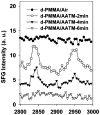Elucidation of molecular structures at buried polymer interfaces and biological interfaces using sum frequency generation vibrational spectroscopy
- PMID: 23710244
- PMCID: PMC3661304
- DOI: 10.1039/C3SM27710K
Elucidation of molecular structures at buried polymer interfaces and biological interfaces using sum frequency generation vibrational spectroscopy
Abstract
Sum frequency generation (SFG) vibrational spectroscopy has been developed into an important technique to study surfaces and interfaces. It can probe buried interfaces in situ and provide molecular level structural information such as the presence of various chemical moieties, quantitative molecular functional group orientation, and time dependent kinetics or dynamics at such interfaces. This paper focuses on these three most important advantages of SFG and reviews some of the recent progress in SFG studies on interfaces related to polymer materials and biomolecules. The results discussed here demonstrate that SFG can provide important molecular structural information of buried interfaces in situ and in real time, which is difficult to obtain by other surface sensitive analytical techniques.
Figures




















Similar articles
-
Investigating buried polymer interfaces using sum frequency generation vibrational spectroscopy.Prog Polym Sci. 2010 Nov 1;35(11):1376-1402. doi: 10.1016/j.progpolymsci.2010.07.003. Prog Polym Sci. 2010. PMID: 21113334 Free PMC article.
-
Engineering and Characterization of Peptides and Proteins at Surfaces and Interfaces: A Case Study in Surface-Sensitive Vibrational Spectroscopy.Acc Chem Res. 2016 Jun 21;49(6):1149-57. doi: 10.1021/acs.accounts.6b00091. Epub 2016 May 18. Acc Chem Res. 2016. PMID: 27188920 Review.
-
Chiral vibrational structures of proteins at interfaces probed by sum frequency generation spectroscopy.Int J Mol Sci. 2011;12(12):9404-25. doi: 10.3390/ijms12129404. Epub 2011 Dec 16. Int J Mol Sci. 2011. PMID: 22272140 Free PMC article. Review.
-
Sum Frequency Generation Vibrational Spectroscopy for Characterization of Buried Polymer Interfaces.Appl Spectrosc. 2017 Aug;71(8):1717-1749. doi: 10.1177/0003702817708321. Epub 2017 Jun 6. Appl Spectrosc. 2017. PMID: 28537432
-
Illustrating consistency of different experimental approaches to probe the buried polymer/metal interface using sum frequency generation vibrational spectroscopy.Soft Matter. 2014 Aug 7;10(29):5390-7. doi: 10.1039/c4sm00582a. Epub 2014 Jun 13. Soft Matter. 2014. PMID: 24926859
Cited by
-
Ion Pairing and Adsorption of Azo Dye/C16TAB Surfactants at the Air-Water Interface.J Phys Chem C Nanomater Interfaces. 2017 Dec 21;121(50):27992-28000. doi: 10.1021/acs.jpcc.7b08924. Epub 2017 Nov 21. J Phys Chem C Nanomater Interfaces. 2017. PMID: 29285205 Free PMC article.
-
Protein Unfolding and Aggregation near a Hydrophobic Interface.Polymers (Basel). 2021 Jan 3;13(1):156. doi: 10.3390/polym13010156. Polymers (Basel). 2021. PMID: 33401542 Free PMC article.
-
Specific effects of Ca(2+) ions and molecular structure of β-lactoglobulin interfacial layers that drive macroscopic foam stability.Soft Matter. 2016 Jul 6;12(27):5995-6004. doi: 10.1039/c6sm00636a. Soft Matter. 2016. PMID: 27337699 Free PMC article.
-
Structure of Polystyrenesulfonate/Surfactant Mixtures at Air-Water Interfaces and Their Role as Building Blocks for Macroscopic Foam.Langmuir. 2017 Apr 11;33(14):3499-3508. doi: 10.1021/acs.langmuir.7b00400. Epub 2017 Mar 28. Langmuir. 2017. PMID: 28318264 Free PMC article.
-
Isoelectric Point of Proteins at Hydrophobic Interfaces.Front Chem. 2021 Jul 30;9:712978. doi: 10.3389/fchem.2021.712978. eCollection 2021. Front Chem. 2021. PMID: 34395381 Free PMC article.
References
-
- Ratner BD, Castner DG. Surface Analysis—The Principal Techniques. John Wiley & Sons; 1997.
-
- McArthur SL. Surf Interface Anal. 2006;38:1380–1385.
-
- Roach P, Parker T, Gadegaard N, Alexander M. Surf Sci Rep. 2010;65:145–173.
-
- Benninghoven A. Surf Sci Rep. 1975;53:596–625.
-
- Henry M, Dupont-Gillain C, Bertrand P. Langmuir. 2003;19:6271–6276. - PubMed
Grants and funding
LinkOut - more resources
Full Text Sources
Other Literature Sources

